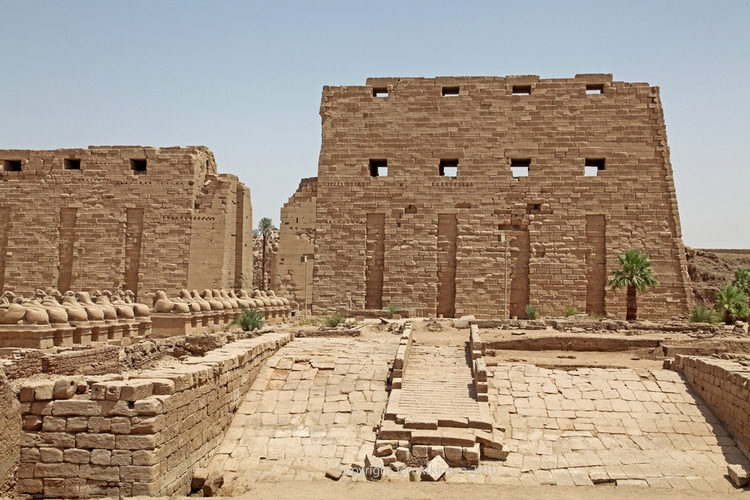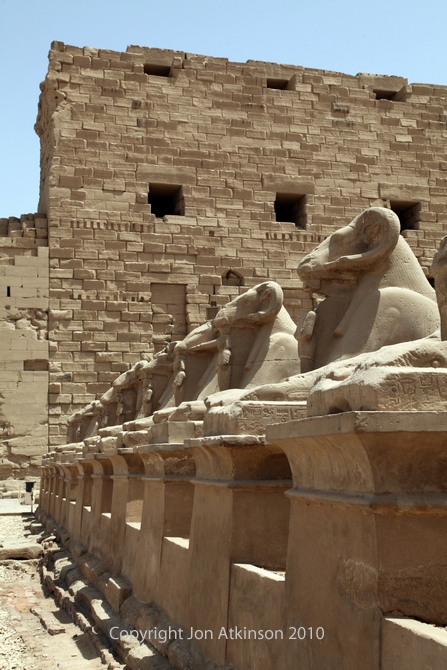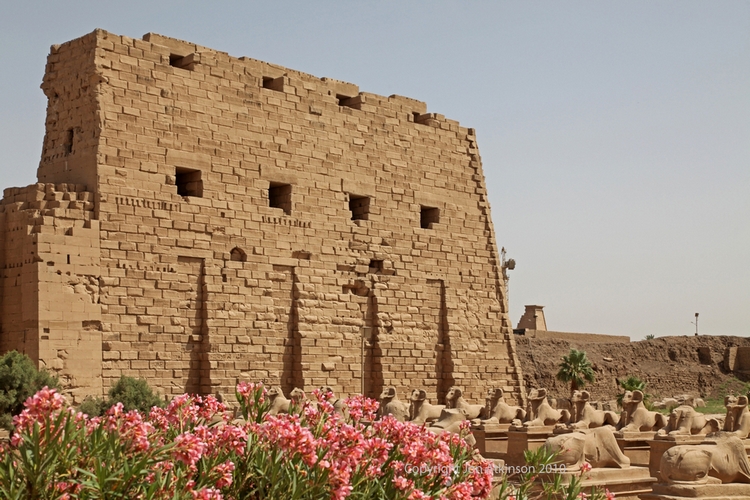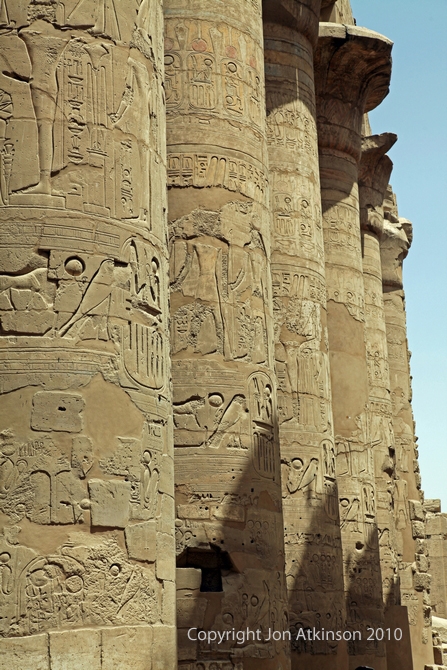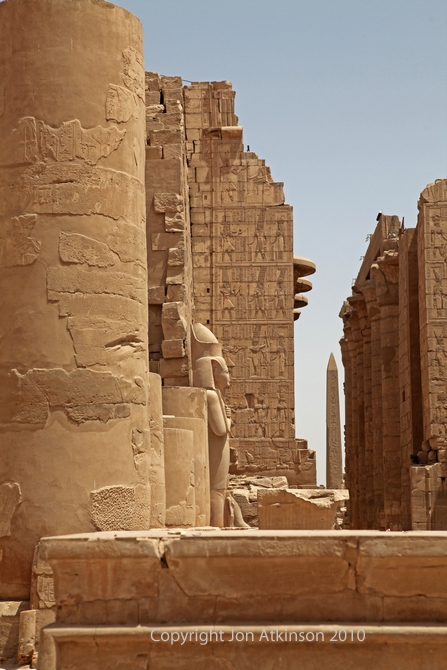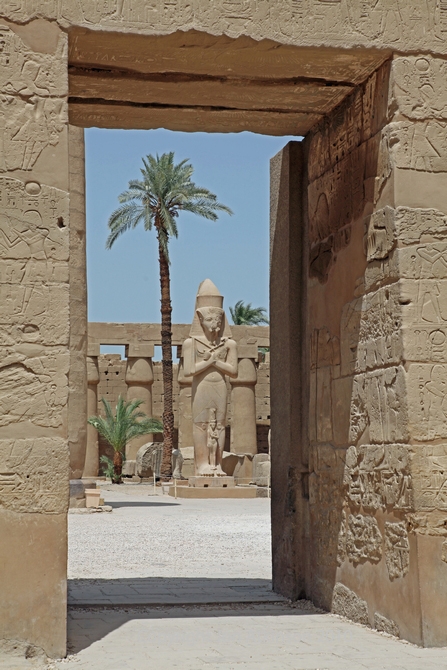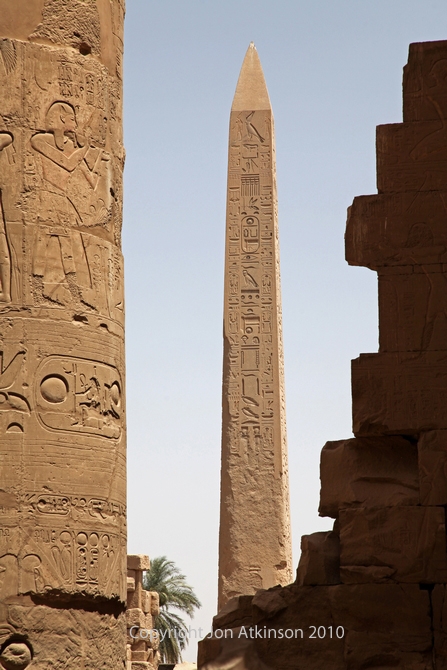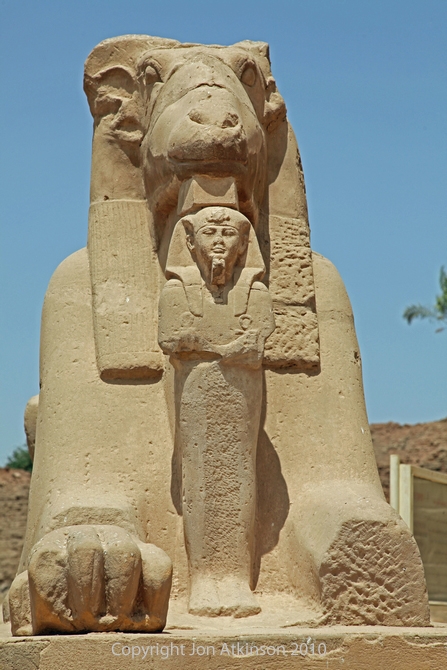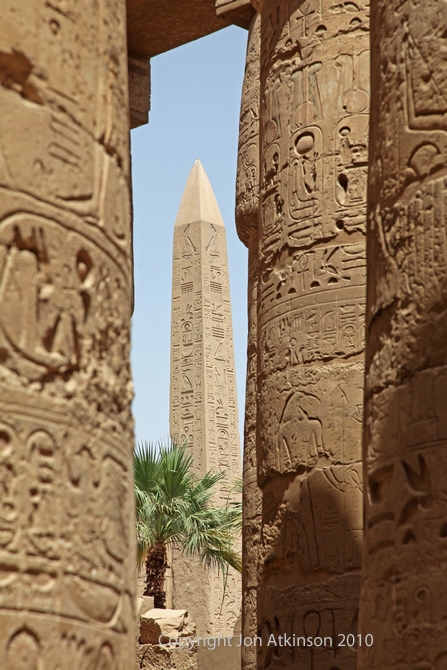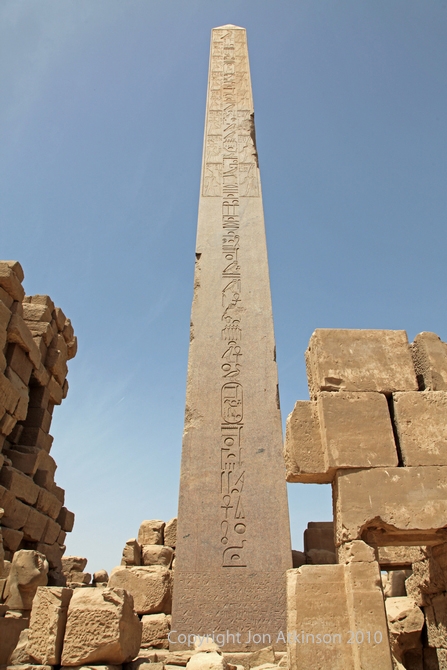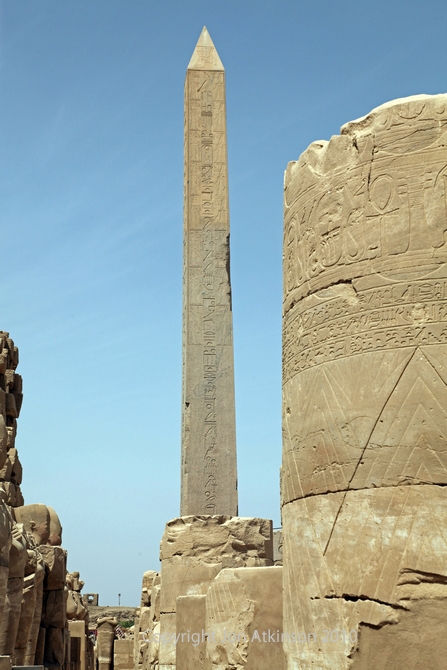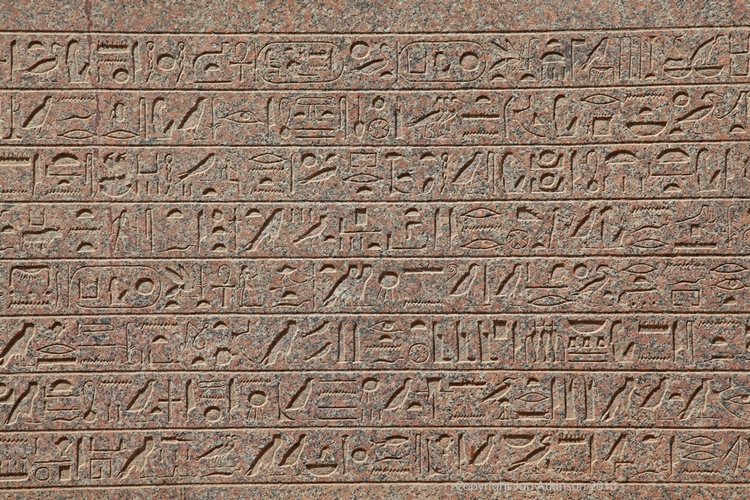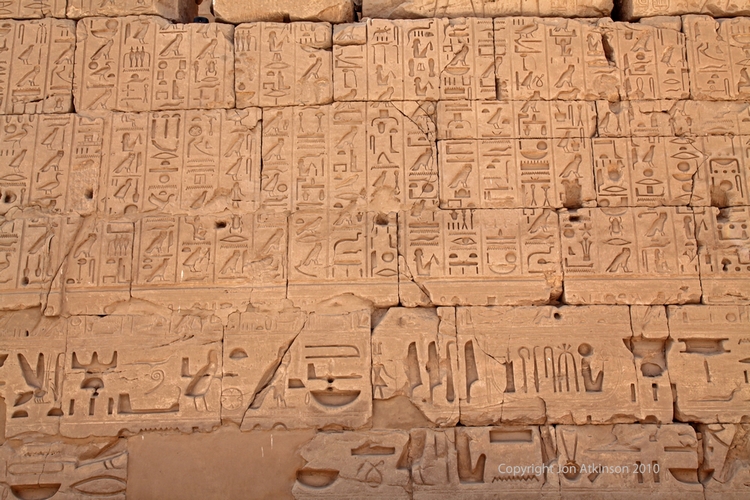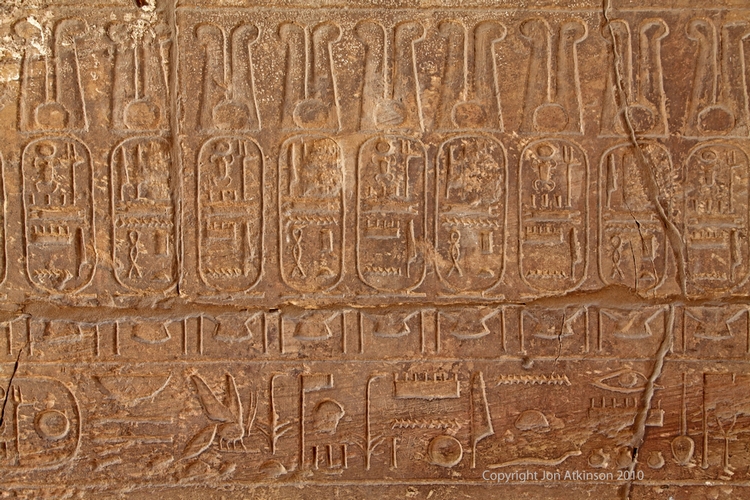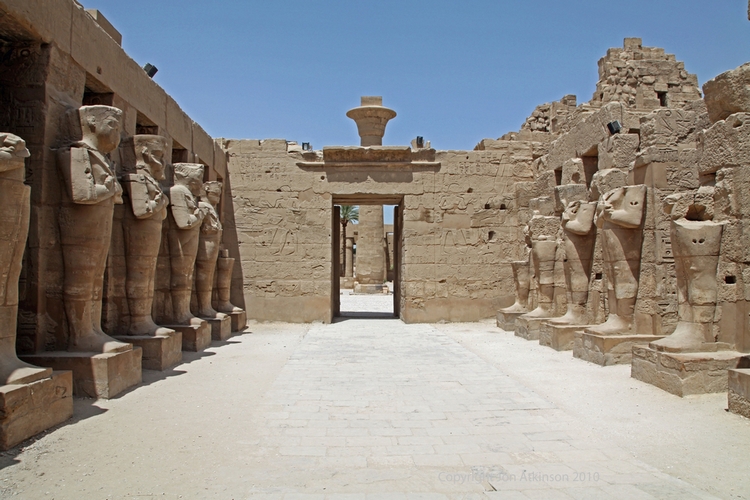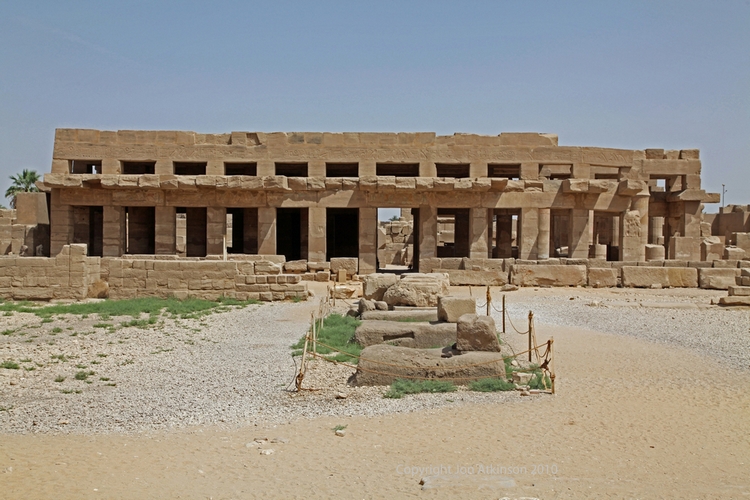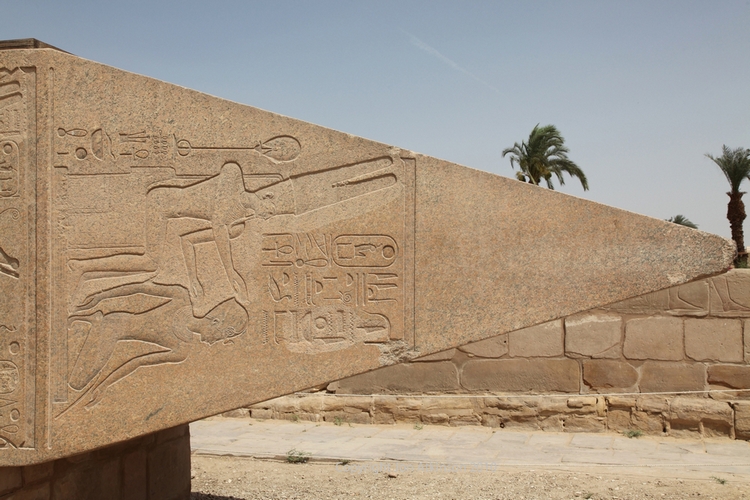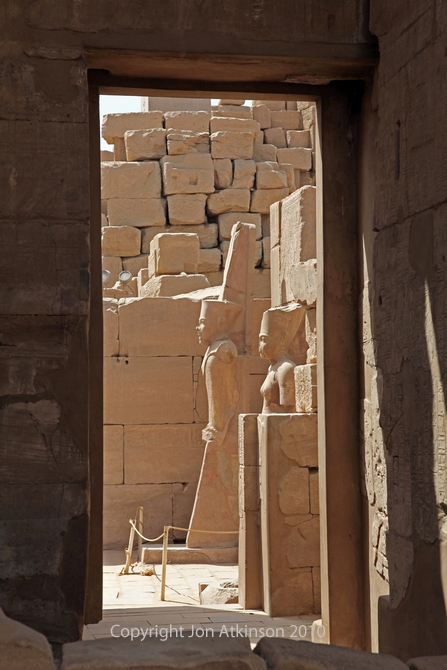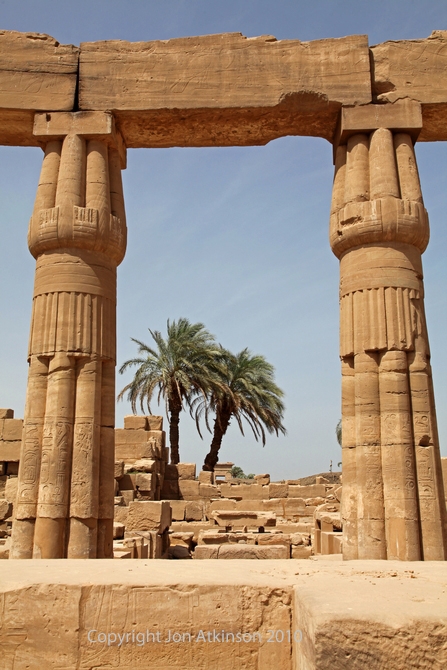Karnak 1 - First Pylon, Karnak Temple: The Temple of Karnak is actually three main temples, smaller enclosed temples, and several outer temples. This vast complex was started in the 16th century BC and enlarged over a thirteen hundred year period. |
Karnak 2 - Avenue of Ram-headed Sphinxes Karnak Temple: The avenue of sphinxes consist of statues with lions' bodies and the heads of rams, symbolizing Amun built around 656 BC. Originally there were three avenues of sphinxes, the longest was two miles long which linked to the avenue of human-headed sphinxes of the temple of Luxor. |
Karnak 3 - First Pylon, Karnak Temple: The first pylon, which is the entrance to the great Temple of Amun, was actually the last to be built, is composed of two massive blocks framing a large portal. The north wing has only thirty-two courses and measures ~22 meters high, while the southern wing (above) has forty-five courses and measures ~32 meters high. Its thickness at the base is ~14.5 meters. |
Karnak 4 - Pillars of the Great Hypostyle Hall from precinct of Amun-Re: The "Great Hypostyle Hall" ceiling was originally almost 25 meters high and was supported by 12 columns with papyrus capitals. The columns are made of sandstone and set in two rows of six. Each row is flanked on either side by 7 rows of columns that are 12.8 meters high.
| Karnak 5 - Second Pylon at Entrance to the Hypostyle Hall, Karnak Temple Complex: The second pylon was built by Horemheb but not completed until the reign of Seti I. Seti’s son Ramesses II built two colossal statues of himself which stood in front of the pylon gate. |
Karnak 6 - Amun-Re, Karnak Temple Complex: Consisting of 134 columns construction on the "Great Hypostyle Hall" began during the reign of Ramesses I, the work was continued by Seti I before being completed by Ramesses II between 1294 and 1213 BC. The hall measures 103m in length and 52m in width and covers an area of 64,000 sq ft.
|
Karnak 8 - Obelisk of Thutmose, Karnak Temple: Tuthmosis I, the father of Hatschepsut, was the first to erect an obelisk in Karnak. It was 22 meters high, made of red granite and had its pinnacle encased in electrum or gold. |
Karnak 9 - Sphinx, Karnak Temple: Each Sphinx along the corridor that leads to the first pylon is depicted with a royal effigy of Ramesses II, in the form of Osiris, protected between their front paws. |
|
Karnak 10 - "Obelisk of Thutmose, Karnak Temple: The use of the obelisks is a mystery. Whilst obelisks are usually covered with inscriptions, these offer no clue to their function, but are instead an indication of by whom and when the obelisk was carved. One theory suggests that the erection of the obelisk was a symbol representing the channel through which the divine spirit might rise to rejoin its source. |
Karnak 11 - "Obelisk of Thutmose, Karnak Temple: The Obelisk of Hatschepsut is made of red quartzite 97 feet (29.6m) high and weighs approximately 320 tons. This is the tallest standing obelisk remaining in Egypt. Only one Obelisk was taller, the one now located in Rome, which is 101 feet (30.7m) high. The two obelisks of Hatshepsut are made of red quartzite. |
Karnak 12 - "Obelisk of Thutmose, Karnak Temple: Egypt use to contain more than a hundred obelisks, however, only nine now stand, a further ten more that lay in situ broken. The rest are buried or have left Egypt where they now stand in the central parks and museum concourses of London, New York, Paris, Rome, Istanbul and other cities. |
Karnak 13 - CHieroglyphics on the Obelisk, Karnak Temple Complex: Close-up of the Hieroglyphics on the Obelisk. |
Karnak 14 - Hieroglyphs in the Temple of Amun in Karnak temple Complex: Hieroglyphs in the Temple of Amun in Karnak, Egypt. |
Karnak 15 - Hieroglyphs in Temple of Ramesses III: Hieroglyphs on the wall of the Temple of Ramesses III in the Karnak temple complex. |
Karnak 16 - Temple of Ramesses III, Karnak Temple Complex: Looking back towards the Great Court from the Temple of Ramesses III. Each side of the Courtyard has a covered passage with eight square pillars fronted by Osiris figures whilst its walls show festival scenes and texts. |
Karnak 17 - Tuthmose III's Great Festival Temple: Tuthmose III's Great Festival Temple which lies beyond an area of Middle Kingdom ruins. The internal columns are unique with an inverted calyx capital in the form of a tent pole. within an antechamber of Tuthmose III's Festival Temple is the so-called Botanical Garden A area of reliefs that record plant, bird and animal species brought back from a campaign to Syria. |
Karnak 18 - Top of Second Obelisk of Hatshepsut: Top of Second Twin Obelisk of Hatshepsut near Sacred Lake, it has broken in two and toppled. Egyptian obelisks were always carved from single pieces of stone, usually pink granite from the distant quarries at Aswan and could take many months to mine from the quarry, in this case 7 months, according to inscriptions at the base. |
Karnak 19 - Ruined statues close to the great festival complex: There are several ruined statues to the north of the hall, in an area which was used as a church in the Coptic era. |
Karnak 20 - Papyrus Capital Colonnade, Karnak Temple Complex: In this photo you can see a colonnade with papyrus capitals. The capitals shown here are closed buds, but they can also be found in an open wide bell-shaped form. |
Karnak 21 - Pillars of the Great Hypostyle Hall from precinct of Amun-Re: Seti I carved his beautiful raised reliefs around the walls of the northern half. His son Ramesses II completed the decoration of the southern half of the walls and pillars, often over carving his father’s reliefs with his own crude sunk relief carvings. |

